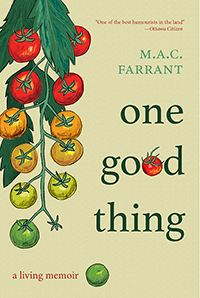Reviews
Nonfiction Review by Christina Mansueti
M. A. C. Farrant, One Good Thing: A Living Memoir (Vancouver: Talonbooks, 2021). Paperbound, 179 pp., $19.95.
 Writer and self‐proclaimed beginner gardener M. A. C. Farrant’s One Good Thing offers many good things in the form of a collection of letters replying to Master Gardener Helen Chesnut’s column in the Victoria Times Colonist. Farrant engages with Chesnut’s practical and metaphorical gardening advice in terms of coping with the tension of living in the dual realities of the everyday and the global. For Farrant, the everyday grows out of home and career, issues of family dynamics, rearing children, the daily struggles of gardening, and her own mortality. The global springs from a world ravaged by corrupt politics, covid‐19, and climate catastrophes. Throughout her memoir, amidst the tension, Farrant searches for the “calm abidance” Chesnut writes with.
Writer and self‐proclaimed beginner gardener M. A. C. Farrant’s One Good Thing offers many good things in the form of a collection of letters replying to Master Gardener Helen Chesnut’s column in the Victoria Times Colonist. Farrant engages with Chesnut’s practical and metaphorical gardening advice in terms of coping with the tension of living in the dual realities of the everyday and the global. For Farrant, the everyday grows out of home and career, issues of family dynamics, rearing children, the daily struggles of gardening, and her own mortality. The global springs from a world ravaged by corrupt politics, covid‐19, and climate catastrophes. Throughout her memoir, amidst the tension, Farrant searches for the “calm abidance” Chesnut writes with.
Structurally, in keeping with the gardening theme, Farrant’s memoir functions like a rhizome, an underground plant stem that grows horizontally, producing the root and shoot system of new plants as they grow. For philosophers Gilles Deleuze and Félix Guattari, a rhizome is also a philosophical concept involving multiplicities and a non‐linear complex of thought. Like a rhizome, One Good Thing presents a complex network of thoughts, and, at the same time, each letter stands on its own. The book is a poetic assemblage, weaving together stories about gardening that metaphorically apply to family, to local and global communities.
Each letter reads as poetic prose, using gardening metaphors “as a way to frame one’s thoughts” and to seed hope for the future. What takes some writers a short story or a novel to express, Farrant does in two‐to‐three‐page letters. For example, in letter two, “Open Trunk,” Farrant begins by responding to Chesnut’s advice to keep the trunk area open so that sunshine and fresh air can penetrate the roots: “I’m always trying to keep the area around my ‘trunk’ open, as you suggest in your column this morning. Or, to put it another way, to receive with openness whatever comes my way.” This lesson is reminiscent of the way Elsie, Farrant’s aunt, raised her. Elsie encouraged her to go outside and take her mind off of herself when she was moody. So, when Farrant’s trunk needs clearing after a visit from family members who overstay their welcome, she takes this advice, goes for a walk, and the dark cloud cover parts allowing the sunshine through. The act of walking frees her from the past and brings her to the present. This act of “keeping the trunk open” becomes a lesson in mindfulness, a method for staying in, or returning to, the present moment.
Her use of metaphor, her understanding of time, and her writerly economy are exemplary. In a matter of sentences, Farrant takes the reader from the present in which she is writing into the past to revisit a lesson learned, then provides them with the possibility of future growth, and finishes in the present. The memoir is structured chronologically in relation to the columns to which Farrant is responding. Each letter changes with the seasonal cycle of life, from rebirth to blossoming, from decline into darkness, and onto seasonal rebirth again. But each individual letter does not operate in linear time. Her literary references to influences such as Kurt Vonnegut and her use of the Eastern contemplative traditions—meditation, Yoga, Buddhism, for example—suggest her understanding of time as neither linear nor cyclical, but simultaneous. Thus, the memoir is simultaneously a reconciliation with her past, an homage to her family and upbringing, and a seed of hope for the future while, in each letter, she is tilling the present uncertainty of life with a sense of mindfulness.
In letter seventeen, “Worms in the Roses,” Farrant is challenged to apply Chesnut’s advice on how to avoid pests in apples, which involves sanitation and monitoring of one’s garden for pest control. While at a friend’s garden party, she encounters the unease in the tension between the everyday and the global. The sudden beauty of the garden is overshadowed by the “continual stream of bad news,” which are the pests of environmental and political changes that are happening in the world: “It’s the beauty in the ordinary, I thought, and felt a sudden longing for the everyday, for its takeover of the global drama.” The challenge for Farrant is to be aware of the immense losses happening in the world, but not be overwhelmed by them, to be aware but detached, compassionate, not indifferent—a challenge with which many of us also struggle.
An abiding concern for the condition of contemporary society, and hope for the future is a tension present throughout One Good Thing, and is characteristic of her other writing. In her 2011 novel The Strange Truth about Us, the structure is also an assemblage of fragmented narratives that stand alone but work simultaneously as part of a whole. While exhibiting the poetics of a writer at the height of her creative and intellectual powers, One Good Thing both invites and supplies reflections on the art of daily living.
—Christina Mansueti









